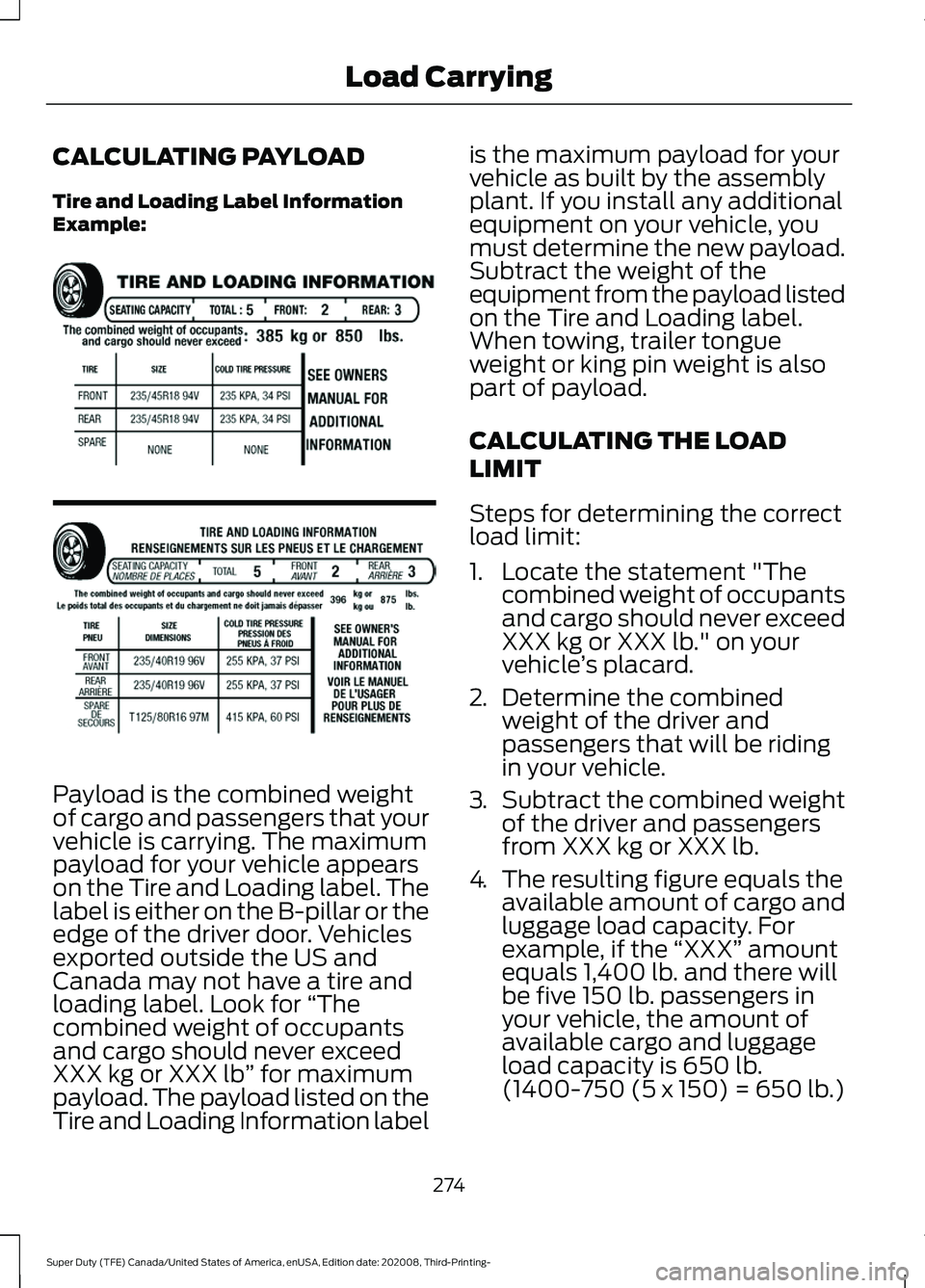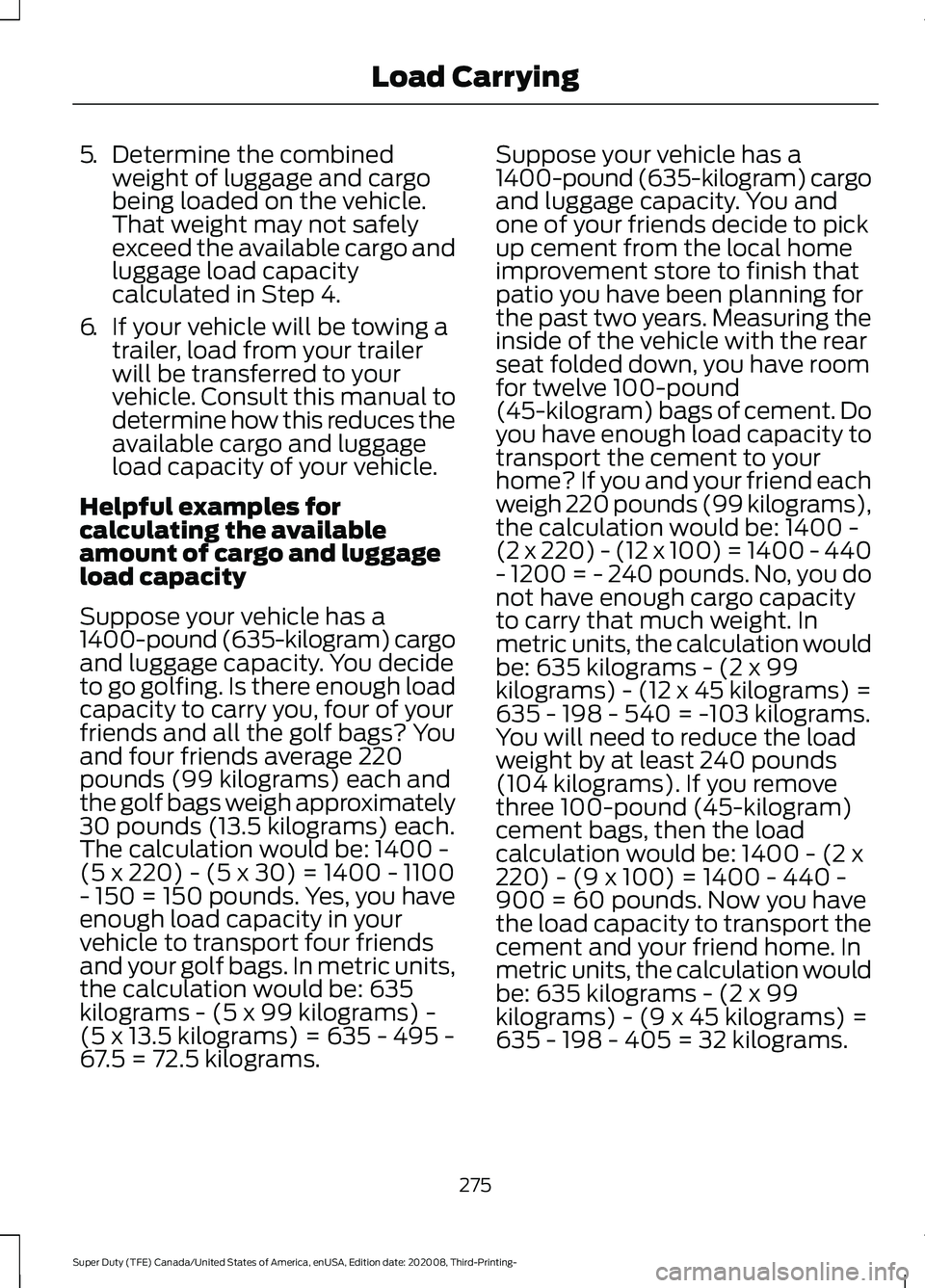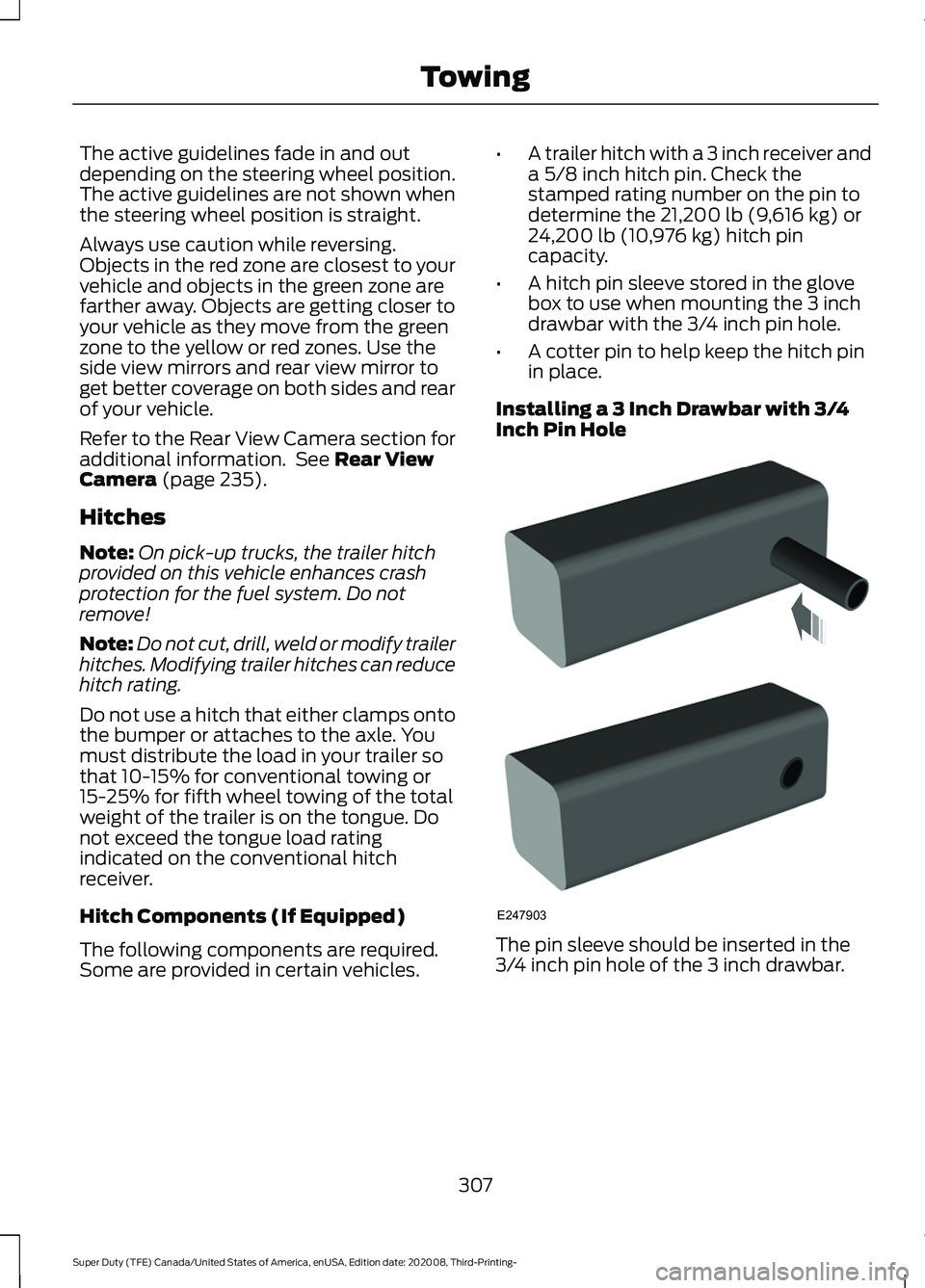2021 FORD F-250 towing capacity
[x] Cancel search: towing capacityPage 277 of 666

CALCULATING PAYLOAD
Tire and Loading Label Information
Example:
Payload is the combined weight
of cargo and passengers that your
vehicle is carrying. The maximum
payload for your vehicle appears
on the Tire and Loading label. The
label is either on the B-pillar or the
edge of the driver door. Vehicles
exported outside the US and
Canada may not have a tire and
loading label. Look for
“The
combined weight of occupants
and cargo should never exceed
XXX kg or XXX lb ” for maximum
payload. The payload listed on the
Tire and Loading Information label is the maximum payload for your
vehicle as built by the assembly
plant. If you install any additional
equipment on your vehicle, you
must determine the new payload.
Subtract the weight of the
equipment from the payload listed
on the Tire and Loading label.
When towing, trailer tongue
weight or king pin weight is also
part of payload.
CALCULATING THE LOAD
LIMIT
Steps for determining the correct
load limit:
1. Locate the statement "The
combined weight of occupants
and cargo should never exceed
XXX kg or XXX lb." on your
vehicle ’s placard.
2. Determine the combined
weight of the driver and
passengers that will be riding
in your vehicle.
3. Subtract the combined weight
of the driver and passengers
from XXX kg or XXX lb.
4. The resulting figure equals the
available amount of cargo and
luggage load capacity. For
example, if the “XXX” amount
equals 1,400 lb. and there will
be five 150 lb. passengers in
your vehicle, the amount of
available cargo and luggage
load capacity is 650 lb.
(1400-750 (5 x 150) = 650 lb.)
274
Super Duty (TFE) Canada/United States of America, enUSA, Edition date: 202008, Third-Printing- Load CarryingE198719
Page 278 of 666

5.
Determine the combined
weight of luggage and cargo
being loaded on the vehicle.
That weight may not safely
exceed the available cargo and
luggage load capacity
calculated in Step 4.
6. If your vehicle will be towing a
trailer, load from your trailer
will be transferred to your
vehicle. Consult this manual to
determine how this reduces the
available cargo and luggage
load capacity of your vehicle.
Helpful examples for
calculating the available
amount of cargo and luggage
load capacity
Suppose your vehicle has a
1400-pound (635-kilogram) cargo
and luggage capacity. You decide
to go golfing. Is there enough load
capacity to carry you, four of your
friends and all the golf bags? You
and four friends average 220
pounds (99 kilograms) each and
the golf bags weigh approximately
30 pounds (13.5 kilograms) each.
The calculation would be: 1400 -
(5 x 220) - (5 x 30) = 1400 - 1100
- 150 = 150 pounds. Yes, you have
enough load capacity in your
vehicle to transport four friends
and your golf bags. In metric units,
the calculation would be: 635
kilograms - (5 x 99 kilograms) -
(5 x 13.5 kilograms) = 635 - 495 -
67.5 = 72.5 kilograms. Suppose your vehicle has a
1400-pound (635-kilogram) cargo
and luggage capacity. You and
one of your friends decide to pick
up cement from the local home
improvement store to finish that
patio you have been planning for
the past two years. Measuring the
inside of the vehicle with the rear
seat folded down, you have room
for twelve 100-pound
(45-kilogram) bags of cement. Do
you have enough load capacity to
transport the cement to your
home? If you and your friend each
weigh 220 pounds (99 kilograms),
the calculation would be: 1400 -
(2 x 220) - (12 x 100) = 1400 - 440
- 1200 = - 240 pounds. No, you do
not have enough cargo capacity
to carry that much weight. In
metric units, the calculation would
be: 635 kilograms - (2 x 99
kilograms) - (12 x 45 kilograms) =
635 - 198 - 540 = -103 kilograms.
You will need to reduce the load
weight by at least 240 pounds
(104 kilograms). If you remove
three 100-pound (45-kilogram)
cement bags, then the load
calculation would be: 1400 - (2 x
220) - (9 x 100) = 1400 - 440 -
900 = 60 pounds. Now you have
the load capacity to transport the
cement and your friend home. In
metric units, the calculation would
be: 635 kilograms - (2 x 99
kilograms) - (9 x 45 kilograms) =
635 - 198 - 405 = 32 kilograms.
275
Super Duty (TFE) Canada/United States of America, enUSA, Edition date: 202008, Third-Printing- Load Carrying
Page 285 of 666

TOWING A TRAILER
WARNING: Do not exceed
the GVWR or the GAWR
specified on the certification
label. WARNING:
Towing trailers
beyond the maximum
recommended gross trailer
weight exceeds the limit of your
vehicle and could result in engine
damage, transmission damage,
structural damage, loss of
vehicle control, vehicle rollover
and personal injury. WARNING:
Do not exceed
the lowest rating capacity for
your vehicle or trailer hitch.
Overloading your vehicle or
trailer hitch can impair your
vehicle stability and handling.
Failure to follow this instruction
could result in the loss of control
of your vehicle, personal injury or
death. WARNING:
Do not cut,
drill, weld or modify the trailer
hitch. Modifying the trailer hitch
could reduce the hitch rating.
Your vehicle may have electrical
items, such as fuses or relays,
related to towing. See
Fuse
Specification Chart (page 339). Your vehicle may have ability to
modify trailer towing features.
See
General Information (page
110).
Your vehicle's load capacity
designation is by weight, not by
volume, so you cannot necessarily
use all available space when
loading a vehicle or trailer.
Towing a trailer places an extra
load on your vehicle's engine,
transmission, axle, brakes, tires
and suspension. Inspect these
components periodically during,
and after, any towing operation.
Note: To prevent your trailer from
accumulating distance, and the
trailer information status appearing
when you restart your vehicle after
disconnecting your trailer, you must
deactivate your trailer. Using the
information display, go to the
Towing menu and then the Select
Trailer option. Select the No active
trailer option. See
General
Information (page 110).
Load Placement
To help minimize how trailer
movement affects your vehicle
when driving:
• Load the heaviest items closest
to the trailer floor.
• Load the heaviest items
centered between the
left-hand and right-hand side
trailer tires.
282
Super Duty (TFE) Canada/United States of America, enUSA, Edition date: 202008, Third-Printing- Towing
Page 310 of 666

The active guidelines fade in and out
depending on the steering wheel position.
The active guidelines are not shown when
the steering wheel position is straight.
Always use caution while reversing.
Objects in the red zone are closest to your
vehicle and objects in the green zone are
farther away. Objects are getting closer to
your vehicle as they move from the green
zone to the yellow or red zones. Use the
side view mirrors and rear view mirror to
get better coverage on both sides and rear
of your vehicle.
Refer to the Rear View Camera section for
additional information. See Rear View
Camera (page 235).
Hitches
Note: On pick-up trucks, the trailer hitch
provided on this vehicle enhances crash
protection for the fuel system. Do not
remove!
Note: Do not cut, drill, weld or modify trailer
hitches. Modifying trailer hitches can reduce
hitch rating.
Do not use a hitch that either clamps onto
the bumper or attaches to the axle. You
must distribute the load in your trailer so
that 10-15% for conventional towing or
15-25% for fifth wheel towing of the total
weight of the trailer is on the tongue. Do
not exceed the tongue load rating
indicated on the conventional hitch
receiver.
Hitch Components (If Equipped)
The following components are required.
Some are provided in certain vehicles. •
A trailer hitch with a 3 inch receiver and
a 5/8 inch hitch pin. Check the
stamped rating number on the pin to
determine the
21,200 lb (9,616 kg) or
24,200 lb (10,976 kg) hitch pin
capacity.
• A hitch pin sleeve stored in the glove
box to use when mounting the 3 inch
drawbar with the 3/4 inch pin hole.
• A cotter pin to help keep the hitch pin
in place.
Installing a 3 Inch Drawbar with 3/4
Inch Pin Hole The pin sleeve should be inserted in the
3/4 inch pin hole of the 3 inch drawbar.
307
Super Duty (TFE) Canada/United States of America, enUSA, Edition date: 202008, Third-Printing- TowingE247903
Page 323 of 666

•
Inspect exhaust system for damage or
looseness.
• Inspect undercarriage fasteners. If any
are loose or damaged, tighten or
replace ensuring that the proper torque
specification is used.
• Inspect the tires for any cuts in the
tread or sidewall area. Also inspect the
sidewall for any bulge indicating
damage to the tire.
• Inspect the wheels for dents, cracks,
or other damage.
• Refit the front license plate if removed
previously.
BREAKING-IN
You need to break in new tires for
approximately 300 mi (480 km). During
this time, your vehicle may exhibit some
unusual driving characteristics.
Avoid driving too fast during the first
1,000 mi (1,600 km)
. Vary your speed
frequently and change up through the
gears early. Do not labor the engine.
Drive your new vehicle at least
1,000 mi
(1,600 km) before towing a trailer. Make
sure you use the specified engine oil. See
Engine Oil Capacity and Specification
(page
449).
Do not add friction modifier compounds
or special break-in oils during the first few
thousand miles (kilometers) of operation.
These additives may prevent piston ring
seating.
DRIVING THROUGH WATER WARNING:
Do not drive through
flowing or deep water as you may lose
control of your vehicle. Note:
Engine damage can occur if water
enters the air filter.
For Vehicles without Tremor Off-
Road Package
Note: Driving through standing water can
cause vehicle damage.
Note: Drive through water in an emergency
only and not as part of normal driving.
Before driving through standing water,
check the depth. Never drive through water
that is higher than the bottom of the wheel
hubs. When driving through standing water, drive
very slowly and do not stop your vehicle.
Your brake performance and traction may
be limited. After driving through water and
as soon as it is safe to do so:
•
Lightly press the brake pedal to dry the
brakes and to check that they work.
• Check that the horn works.
• Check that the exterior lights work.
• Turn the steering wheel to check that
the steering power assist works.
320
Super Duty (TFE) Canada/United States of America, enUSA, Edition date: 202008, Third-Printing- Driving HintsE176913
Page 359 of 666

3. Add engine oil that meets the correct
specification.
4. Recheck the oil level.
5. If the oil level is correct, replace the dipstick and make sure it is fully seated.
6. Replace the engine oil filler cap. Turn it clockwise until you feel a strong
resistance.
Note: Do not add oil further than the
maximum mark. Oil levels above the
maximum mark may cause engine damage.
Note: Make sure you install the oil filler cap
correctly.
Note: Soak up any spillage with an
absorbent cloth immediately.
CHANGING THE ENGINE OIL
AND OIL FILTER
If your vehicle is equipped with a diesel
engine, an Intelligent Oil Life Monitor™
calculates the proper oil change service
interval. When the information display
indicates: OIL CHANGE REQUIRED, change
the engine oil and oil filter. See
Information Displays (page 110).
The engine oil filter protects your engine
by filtering harmful, abrasive or sludge
particles and particles significantly smaller
than most available will-fit filters. See
Motorcraft Parts
(page 443).
1. Unscrew the oil filter and oil pan drain plug and wait for the oil to drain.
2. Replace the filter.
Note: Do not handle hot oil filter with bare
hands.
3. Reinstall the oil pan drain plug.
4. Refill the engine with new oil. See Engine Oil Capacity and
Specification
(page 449). 5. For diesel engines, you need to reset
the Intelligent Oil Life Monitor™. See
Information Displays
(page 110).
Engine lubrication for severe
service operation
The following conditions define severe
operation for which engine operation with
SAE 5W-40 that meets our specification
WSS-M2C171-F1 is recommended. Oil and
oil filter change intervals will be
determined by the Intelligent Oil Life
Monitor™ as noted previously.
• Frequent or extended idling (over 10
minutes per hour of normal driving).
• Low-speed operation/stationary use.
• If vehicle is operated in sustained
ambient temperatures below
-9°F
(-23°C) or above 100°F (38°C).
• Frequent low-speed operation,
consistent heavy traffic less than
25 mph (40 km/h)
.
• Operating in severe dust conditions.
• Operating the vehicle off road.
• Towing a trailer over
1,000 mi
(1,600 km).
• Sustained, high-speed driving at Gross
Vehicle Weight Rating (maximum
loaded weight for vehicle operation).
• Use of fuels with sulfur content other
than ultra-low sulfur diesel (ULSD).
• Use of high-sulfur diesel fuel.
OIL CHANGE INDICATOR
RESET
Use the information display controls on
the steering wheel to reset the oil change
indicator.
356
Super Duty (TFE) Canada/United States of America, enUSA, Edition date: 202008, Third-Printing- Maintenance
Page 655 of 666

Severe Climates.................................................
365
Engine Coolant Check - 6.7L Diesel............................................................368
Adding Coolant.................................................. 368
Coolant Change................................................... 371
Engine and Secondary Cooling System Refill Procedure............................................. 370
Engine-driven Cooling Fan.............................. 371
Recycled Coolant............................................... 370
Severe Climates................................................... 371
Engine Coolant Check - 7.3L.....................371 Adding Coolant................................................... 372
Coolant Change.................................................. 374
Engine Coolant Temperature Management.................................................. 375
Engine-driven Cooling Fan (Fan Clutch).............................................................. 374
Fail-Safe Cooling................................................ 374
Recycled Coolant............................................... 373
Severe Climates.................................................. 374
Engine Emission Control...........................194
Engine Idle Shutdown.................................182
Engine Immobilizer See: Passive Anti-Theft System..................... 76
Engine Oil Capacity and Specification - 6.2L................................................................449
Alternative Engine Oil for Extremely Cold Climates ........................................................... 450
Engine Oil Capacity and Specification - 6.7L Diesel...................................................450
Alternative Engine Oil for Biodiesel Fuel Blends (B20 Max)........................................ 452
Alternative Engine Oil for Extremely Cold Climates........................................................... 452
Alternative Engine Oil for Severe Duty Service.............................................................. 453
Engine Oil............................................................. 450
Engine Oil Capacity and Specification - 7.3L.................................................................453
Alternative Engine Oil for Extremely Cold Climates........................................................... 454
Engine Oil Check - 6.2L..............................352 Adding Engine Oil.............................................. 353
Engine Oil Check - 6.7L Diesel................354 Adding Engine Oil.............................................. 354
Engine lubrication for severe service operation ......................................................... 355Engine Oil Check - 7.3L..............................355
Adding Engine Oil.............................................. 355
Engine Oil Dipstick - 6.2L..........................352
Engine Oil Dipstick - 6.7L Diesel.............352
Engine Oil Dipstick - 7.3L...........................352
Engine Specifications - 6.2L.....................441 Drivebelt Routing................................................ 441
Engine Specifications - 6.7L Diesel.......441 Drivebelt Routing............................................... 442
Engine Specifications - 7.3L.....................442 Drivebelt Routing............................................... 443
Entertainment................................................521 AM/FM Radio...................................................... 522
Apps....................................................................... 530
CD........................................................................\
.... 528
HD Radio ™ Information (If
Available)......................................................... 525
SiriusXM® Satellite Radio (If Activated)........................................................ 523
Sources.................................................................. 522
Stereo or USB..................................................... 529
Supported Media Players, Formats and Metadata Information................................ 530
USB Ports............................................................. 530
Environment.....................................................19
Essential Towing Checks..........................305 Before Towing a Trailer..................................... 313
Dynamic Hitching Using the Rear View Camera System............................................ 306
Hitches................................................................... 307
Integrated Trailer Brake Controller...............310
Launching or Retrieving a Boat or Personal Watercraft (PWC)......................................... 314
Safety Chains..................................................... 309
Trailer Brakes...................................................... 309
Trailer Lamps........................................................ 313
Trailer Towing Connector............................... 305
When Towing a Trailer...................................... 313
Event Data Recording See: Data Recording.............................................. 11
Export Unique Options
.................................18
Extending the Remote Start Duration........................................................140
Exterior Mirrors
................................................96
Blind Spot Information System...................... 99
Clearance Lamps ................................................ 98
Direction Indicator Mirrors ............................... 98
Fold-Away Exterior Mirrors............................... 96
652
Super Duty (TFE) Canada/United States of America, enUSA, Edition date: 202008, Third-Printing- Index
Page 656 of 666

Heated Exterior Mirrors .....................................
98
Memory Mirrors ................................................... 98
Power Exterior Mirrors........................................ 96
PowerScope ™ Power Telescoping
Mirrors.................................................................. 97
Puddle Lamps....................................................... 98
Spot Lamps........................................................... 98
Telescoping Mirrors.............................................. 97
Trailer Towing Camera System....................... 98
F
Fastening the Seatbelts..............................39
Fastening the Cinch Tongue............................ 40
Seatbelt Locking Modes..................................... 41
Using Seatbelts During Pregnancy...............40
Using the Seatbelt with Cinch Tongue (Front Center Seat on Super Cab and
Crew Cab).......................................................... 39
Flat Tire See: Changing a Road Wheel....................... 429
Floor Mats
.......................................................323
Fog Lamps - Front See: Front Fog Lamps........................................ 89
Foot Pedals See: Adjusting the Pedals................................. 84
Ford Credit
.........................................................15
US Only..................................................................... 15
Ford Protect...................................................563 Ford Protect Extended Service Plan
(CANADA ONLY).......................................... 564
Ford Protect Extended Service Plans (U.S. Only).................................................................. 563
Four-Wheel Drive
..........................................213
Front Axle Fluid Capacity and Specification..............................................466
Front Fog Lamps
............................................89
Front Fog Lamp Indicator................................. 89
Switching the Front Fog Lamps On or Off........................................................................\
. 89
Fuel and Refueling
.......................................184
Fuel Consumption........................................193
Advertised Capacity.......................................... 193
Fuel Economy...................................................... 193
Fuel Filter - 6.2L/7.3L..................................382
Fuel Quality - Diesel.....................................187 Biodiesel................................................................ 188
Diesel Fuel Additives ........................................ 189Fuel Requirements - Choosing The Right
Fuel: Vehicles Operated Where Ultra Low
Sulfur Diesel Fuel Is Not Required ..........187
Fuel Requirements - Choosing The Right Fuel: Vehicles Operated Where Ultra Low
Sulfur Diesel Fuel Is Required (United
States/Canada/Puerto Rico/U.S. Virgin
Islands And Other Locales) ...................... 187
Fuel Quality - E85........................................185 Choosing the Right Fuel - Flex Fuel
Vehicles............................................................. 185
Switching Between E85 and Gasoline............................................................ 186
Fuel Quality - Gasoline..............................186 Choosing the Right Fuel.................................. 186
Fuel Shutoff...................................................326
Fuel Tank Capacity - Diesel.....................457
Fuel Tank Capacity - Gasoline...............458
Fuses
................................................................339
Fuse Specification Chart..........................339 Engine Compartment Fuse Box................... 339
Passenger Compartment Fuse Panel.................................................................. 343
G
Garage Door Opener
...................................164
Garage Door Opener See: Universal Garage Door Opener...........164
Gauges ..............................................................
102
DEF Gauge............................................................ 104
Engine Coolant Temperature Gauge..........104
Engine Oil Pressure Gauge............................. 104
Fuel Gauge............................................................ 104
Transmission Fluid Temperature Gauge................................................................. 104
Turbo Boost Gauge............................................ 104
Type 1 and 2.......................................................... 102
Type 3..................................................................... 103
Gearbox See: Transmission.............................................. 207
General Information on Radio Frequencies...................................................55
Intelligent Access................................................. 55
General Maintenance Information.......565 Multi-Point Inspection..................................... 568
Owner Checks and Services......................... 566
Protecting Your Investment........................... 565
653
Super Duty (TFE) Canada/United States of America, enUSA, Edition date: 202008, Third-Printing- Index